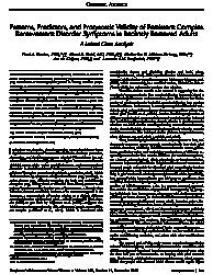Patterns, Predictors, and Prognostic Validity of Persistent Complex Bereavement Disorder Symptoms in Recently Bereaved Adults : A Latent Class Analysis
Persistent complex bereavement (PCBD) was entered to DSM-5. No studies have yet examined the nature, prevalence, prognostic validity, and underlying mechanisms of PCBD symptom patterns in recently bereaved people. Knowledge on these issues could improve the early identification and treatment of disturbed grief. Latent class analysis was used to identify subgroups characterized by different PCBD symptom patterns among recently (≤6 months) bereaved adults (n = 476). In a subgroup (n = 251), we assessed associations of class membership with PCBD severity and functional impairment assessed 3 years later. Associations between class membership and sociodemographic and cognitivebehavioral variables were also examined. We identified a resilient (50.0%), separation distress (36.1%), and high PCBD symptoms (13.9%) class. Class membership had prognostic value as evidenced by associations with PCBD severity and functional impairment assessed 3 years later. Deaths of partners/children, unexpectedness of the loss, and maladaptive cognitions and avoidance behaviors were also associated with membership of the pervasive symptom classes.
Geachte bezoeker,
De informatie die u nu opvraagt, kan door psychotraumanet niet aan u worden getoond. Dit kan verschillende redenen hebben,
waarvan (bescherming van het) auteursrecht de meeste voorkomende is. Wanneer het mogelijk is om u door te verwijzen naar de bron
van deze informatie, dan ziet u hier onder een link naar die plek.
Als er geen link staat, kunt u contact opnemen met de bibliotheek,
die u verder op weg kan helpen.
Met vriendelijke groet,
Het psychotraumanet-team.
In: The Journal of Nervous and Mental Disease ISSN: 0022-3018 | 207 | 11 | November | 913-920
https://doi.org/10.1097/NMD.0000000000001053


